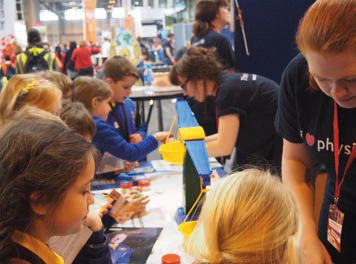
Physiology News Magazine
Obesity outreach activities
News and Views
Obesity outreach activities
News and Views
Anisha Tailor
Outreach Officer, The Physiological Society
https://doi.org/10.36866/pn.96.11
Take a moment to ponder that common cliché ‘one size fits all’. There are few occasions, if any, when we can honestly say that this phrase holds true. Exercise, diet, hormones, genes – the physiology of obesity is certainly an area where diversity reigns supreme.
For 2014, The Society has shone the light on this controversial topic, and through a united front we have worked to clear up myths and misconceptions, by highlighting the physiological causes and consequences of this global epidemic.
Obesity is becoming a growing health concern in the UK. A quick Google of the terms ‘obesity’, ‘fat’ and ‘overweight’ and you are greeted with over 14,100,000 results. With the internet being one of the main sources of the information we consume, it is easy to see how misinformation and confusion can spread. As part of our themed year we have aimed to create a dialogue around the physiological side of obesity through a range of outreach and public engagement events.
We started the ball rolling in February with a public lecture from Alexandra Blakemore. The Professor of Human Molecular Genetics at Imperial College London joined us in our new home, Hodgkin Huxley House, to discuss a subject which is often met with public vitriol, the relationship between genes and obesity.
While sedentary lifestyles and overindulgence get the brunt of the blame for increasing waistlines, the genetic side remains relatively in the background. Alex, however, is a firm believer that genes are indeed an extremely important factor, and that ‘understanding the genetics of obesity will help us deal with a growing and very important problem’.
In her lecture, entitled ‘Genetics and the prospect of personalised medicine for obesity’,Alex highlighted twin studies as an indication of the link between obesity and genes: identical twins are far more likely to both be obese than non-identical twins. So why is there so much doubt, ‘how does it make logical sense to say our height is controlled by our genes but not our width?’ Alex went on to discuss her work in finding and investigating the genetic difference between individuals which plays a role in adiposity and how this information can be used to inform a personalised route of care in dealing with the issue.
Our discussion on genes continued in April at Edinburgh International Science Festival. This time Colin Moran, lecturer at Stirling University, was its advocate. Colin was joined by Julian Mercer (University of Aberdeen), Tony Goldstone (Imperial College London) and Naomi Brooks (Stirling University) to explore the causes of obesity in our panel discussion ‘Separating the fat from the fiction’. Over the 90 minutes session, each speaker took to the stage campaigning that their cause was the most important factor, and quizzing the audience along the way with the use of interactive voting buttons.
In June we attended Cheltenham Science Festival with our talk ‘The BMI Lie’. Our speakers, Janice Thompson, Jason Gill and self-proclaimed lover of fat Jimmy Bell, discussed the pros and cons of using BMI as a measure of health. Our expert physiologists talked about how health risks varied between different ethnicities, and the risk factors associated with subcutaneous and visceral fat.
Alongside our adults’ engagement we also took our theme to younger audiences. With a troop of knowledgeable volunteers, and three neatly packed boxes, we travelled to Birmingham for The Big Bang Fair, an annual event to promote science, technology, engineering and maths (STEM), and Cheltenham Discover Zone, a hands-on area of Cheltenham Science Festival.

Inside our boxes ‘The Hungry Games’ popped out, a collection of hands-on activities delving into the hormonal pathways behind appetite in the activity ‘Look who’s talking’, energy balance and weight management in ‘It’s balancing act’, and a deeper look at how fat is distributed around the body, and the differences between ‘healthy’ and ‘overweight’ in our card game ‘Play your BMI right’. Thousands of school pupils, teachers and parents engaged with our stand, questioning us on the use of hormones in diet drugs, and how a young Arnold Schwarzenegger could possibly be considered obese. ‘The Hungry Games’ still has another stop to make this year: it will be making its way up to Newcastle for our ‘Fair of Physiology’, a day of interactive science for local schools running alongside our Obesity Meeting in St James’ Park, Newcastle-upon-Tyne.
It’s been a fantastic year, and we would like to thank all of our hard-working volunteers, our expert speakers, and our very knowledgeable advisers. We hope next year’s programme of events will be just as exciting as we tackle our 2015 theme ‘Understanding Ageing’.
The Society has been working with other organisations to develop a public programme of outreach events for out themed year of ‘Understanding Obesity’. We would like to thank The Biochemical Society, The Nutrition Society, the University of Essex, Imperial College London, Heriot Watt University and the University of Stirling.
Alexandra Blakemore’s full lecture can be found on The Physiological Society’s YouTube Channel.
